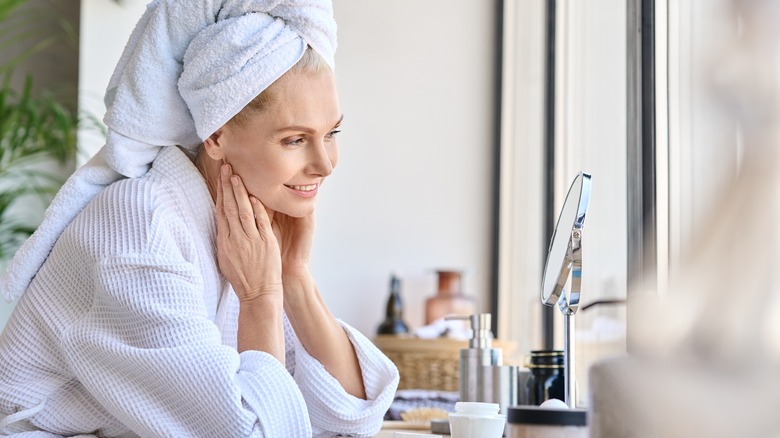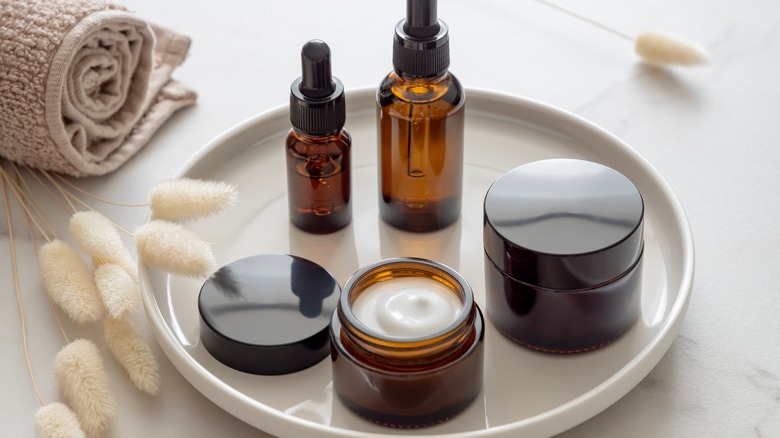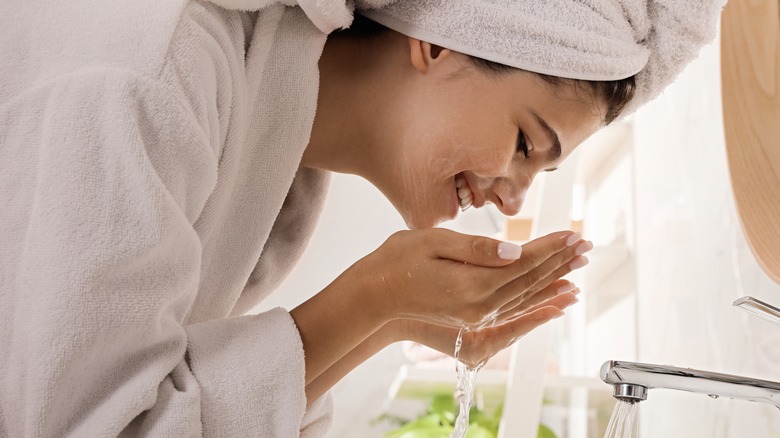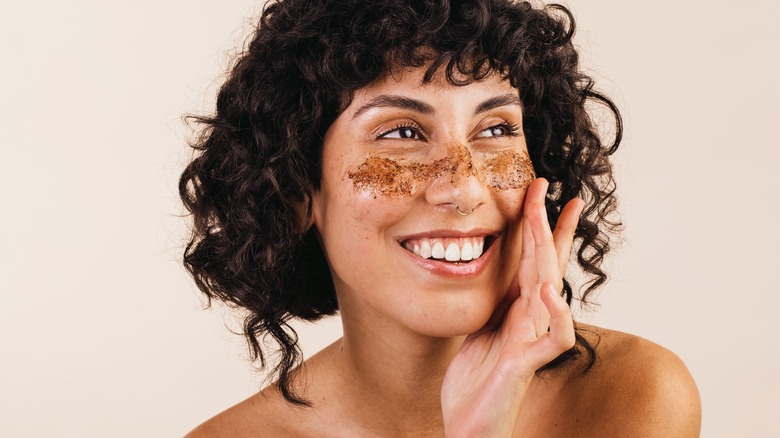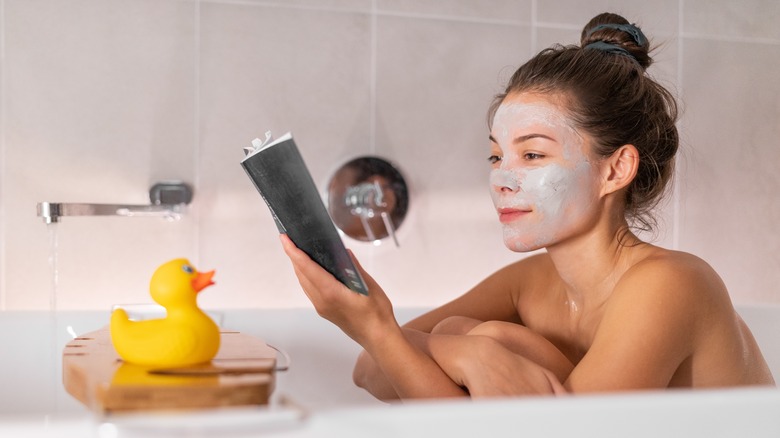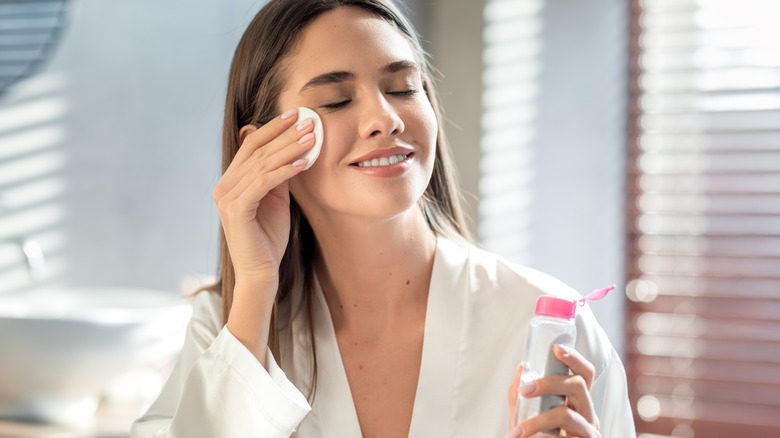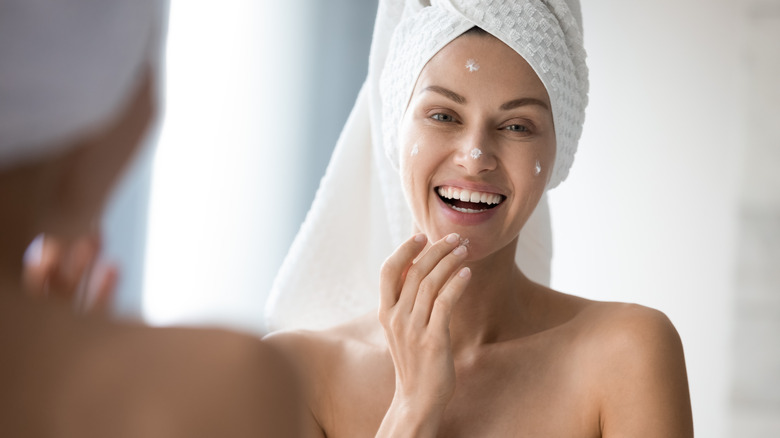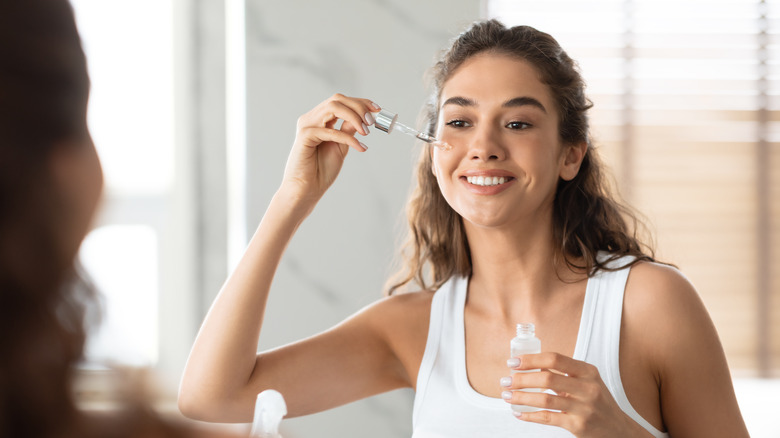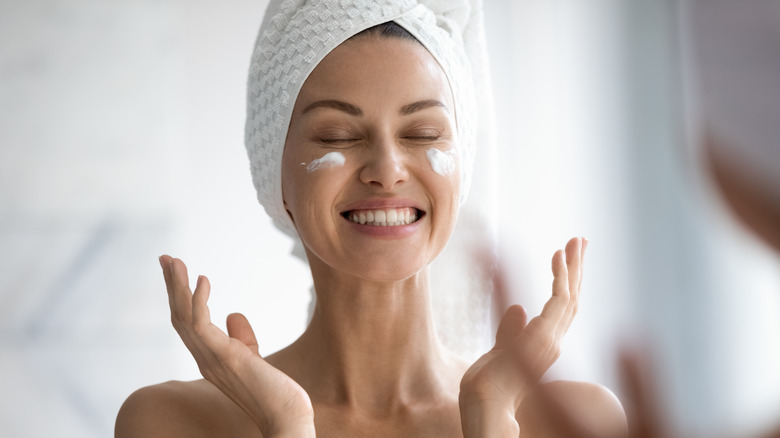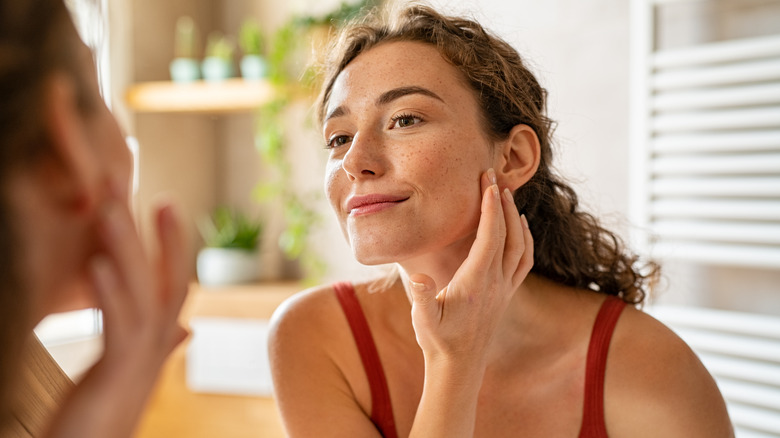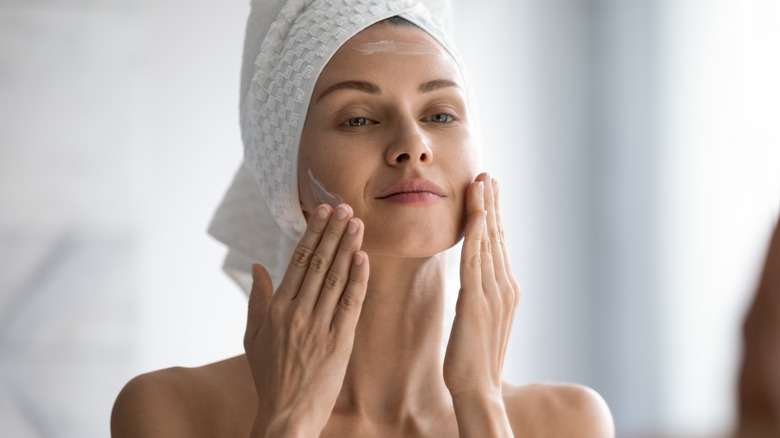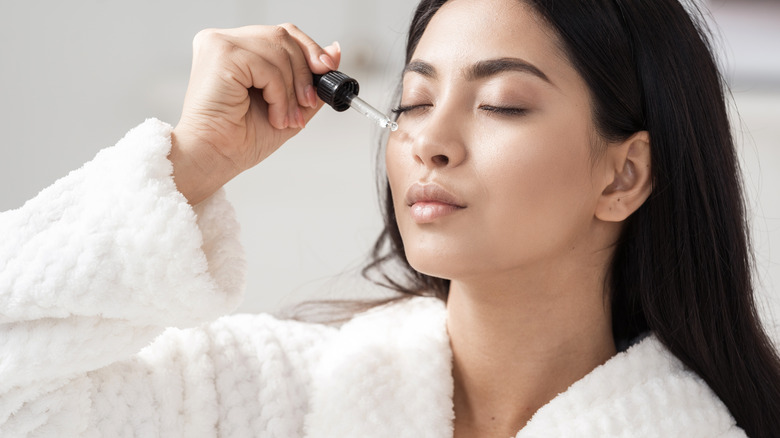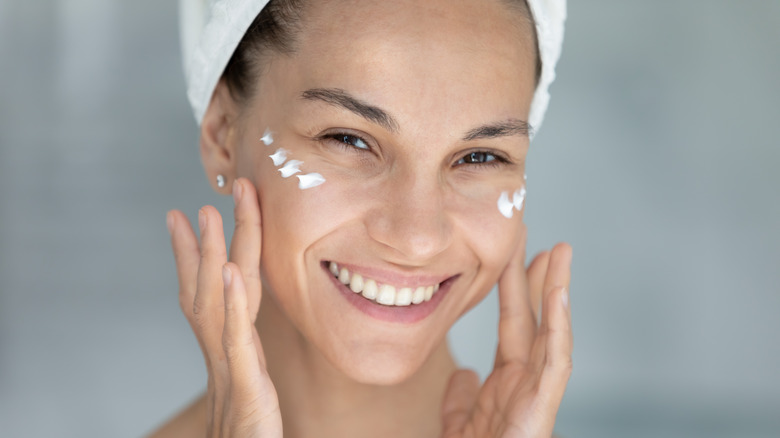Here's Exactly How Long Each Of Your Skincare Steps Should Take
We may receive a commission on purchases made from links.
Taking care of your skin and getting a glowing complexion can be a bit of a challenge sometimes. Between work meetings, alarm clocks going off, and after-work fatigue, taking time out for yourself is no easy job. Still, having a beauty routine can help solve many skin problems resulting from a hectic lifestyle. Indeed, it "will [...] keep you looking and feeling your best throughout the year," declares dermatologist Steven Nwe, D.O., from Northwestern Medicine. Whether it is composed of two to three products like the minimalist J-beauty routine, which is inspired by ancestral traditions of Japan or made up of a dozen products like the ever-popular 10-step K-beauty routine, a beauty routine requires time, patience, and motivation.
Believe it or not, it isn't enough to simply do cocktailing — aka layering and mixing skincare products to create your perfect beauty routine — as advised by skincare expert and esthetician Renée Rouleau. Between knowing how long it takes for your skin to be thoroughly cleansed, how many minutes sunscreen needs to penetrate the epidermis, and more, there are many questions that can turn your simple beauty routine into a real nightmare.
However, dermatologists are not afraid to reveal their secrets and give you a little idea about what to do so that you don't make the same mistake again during your next routine. If having your own skincare routine is the first step to improving the aspect of your skin, the time you spend on it is just as important, so here's exactly how long each of your skincare steps should really take.
Why does waiting between products matter?
Even if the only thing you want to do at night after getting home from work is to put on your pajamas and fall into a deep sleep, your skin will remind you to take care of it because it requires special attention, especially if it is sensitive, acne-prone, and you're interested in changing the appearance of your skin. Having a beauty routine is therefore essential to keep it healthy.
If the order of the products is important because it "means better, more noticeable results in the long run," dermatologist Dr. Harold Lancer tells E! News. It is even more important to know how long each skincare product takes to penetrate the skin. You can't just apply one product after another without letting them penetrate into it. Indeed, "if you have many steps, pause for a bit to allow each product time to react with the skin," adds board-certified dermatologist Heather Rogers to Dermstore. The products' molecules need seconds to minutes to reach the epidermis without another product altering its effectiveness.
Cleanser
After spending a day outside, your skin has sweated and been in contact with pollution and dozens of people. Whether you've been wearing makeup or not, your skin requires a good cleanse. The purpose of a cleanser is to help, as its name suggests, to thoroughly clean your pores. It will remove impurities and pollution particles that have settled on your skin, as well as dirt that's accumulated during the day. This is the first and most important step in a skincare routine. "Otherwise, this leads to improper absorption and clogging", explains Dr. Chytra Anand (via Brides Today).
To be sure you have properly removed all impurities, use the 60-second rule. This medically recommended technique, which also created a buzz on social media, consists of washing your face for 60 seconds — no more, no less. It is widely used in the world of skincare and is even approved by Rachael Ostrea, the medical aesthetician who told Hero Cosmetics, "Washing for a minute allows the cleanser to remove oil, makeup, and dirt buildup. Since it's the first step in any routine, making sure you fully cleanse your skin for long enough is imperative." When you have completed the first step of your routine, your skin is immediately ready for a new product. Apply it before two minutes have passed. "This approach allows for your [products] to be 'locked-in' before it has a chance to evaporate from your skin," adds Ostrea.
Exfoliator
Cleansing your skin helps to get rid of most impurities accumulated during the day, but some remain incrusted into your skin. As a result, your pores are clogged, and dead skin remains on the surface of the epidermis. Nowadays, though, a beauty method exists to get that peachy, clear, and blemish-free skin we all dream of: exfoliation. As a matter of fact, the skin needs to be exfoliated to regenerate itself.
Exfoliation is a ritual that should never be neglected in your beauty routine. It reveals new skin and therefore a complexion that is less dull, clearer, and more radiant with fewer blackheads and even fewer pimples. What's more, a study conducted by Plastic Reconstructive Surgery Global Open states that exfoliation "stimulates cell turnover, resulting in a more polished, smoother, translucent surface." Whether your exfoliator is DIY or store-bought, it should be scrubbed on your face with circular motions for a maximum of one minute so as not to leave your skin with more blemishes (via Skincare Geeks). It's also recommended not to exfoliate more than two times per week. In fact, over-exfoliating can weaken the skin, creating redness and destroying the skin's natural barrier, per Kate Somerville.
Face masks
You are relaxing in your bath and watching your favorite show with a skincare mask on your face. Your skin will be hydrated, more radiant, free of deficiencies, and full of vitality. It only took you a few minutes to spread it on your skin, so what could go wrong? Well, if you thought you could watch an entire episode of the TV show you are binge-watching, you are wrong. A face mask can be on for a maximum of 20 minutes so that it doesn't produce the opposite effect and dry out the skin, per Healthline.
Each mask is unique, so it's essential to read the instructions on the product packaging to know how long you should leave it on. "Typically, masks will do their job in about 1- minutes, with the exception of overnight sleep treatments designed to work over a number of hours," explains Lee Etheridge, the executive director of global education at BareMinerals. In addition, it's recommended not to do facial masks every day and to limit yourself to one or two per week.
Toner
Toner is a water-based skincare product that is a true favorite of K-beauty lovers. Toner helps to balance skin's natural pH levels and maintain it at its optimal level of ~5.5 pH (via research published in the Journal of Cosmetic Science), as well as to hydrate and protect it. As a true concentrate of science, this product will complete your cleansing, reduce the appearance of pores, hydrate, exfoliate, and more, which makes it an indispensable product for your skin.
If you have a spray toner, simply apply it directly to your face and wait a few minutes for it to dry. If it's a liquid toner, soak a cotton ball in it, and then gently pat it over your face. You can also apply light pressure on the cotton pad so that the toner soaks into your epidermis. In just a few minutes, you have helped your skin feel fresher, more soothed, and cleaner (via Root Science). Toner isn't the skincare routine product that takes the longest to apply, which makes it even better. A few seconds of application combined with a few minutes of waiting can make you have porcelain-doll-like skin over time.
Spot treatments
In the coming days, you have a date with what could be your happily ever after, but out of luck, a couple of pimples have appeared in the middle of your face! To save your date, you'll need to add a specific treatment to take care of your pimples and spots into your evening routine. Spot treatments are an ideal way to combat an existing pimple and even help to prevent a new one from forming. Specifically formulated to dry out the pimple locally, those medication creams help soothe them and reduce inflammation. Simply apply a pea-sized amount of product onto your fingers, making sure you have washed your hands beforehand, before dabbing it on your pimples. Massage it gently on the affected areas for 60 seconds, depending on your skin's needs.
When you apply it to the irritated area, give your skin a few seconds to rest before following up with another skincare product. "Prescription medications [...] need to be absorbed fully before secondary creams are applied, but that should take less than a minute," explains New York City-based dermatologist Rachel Nazarian to The Klog.
Serums
Vitamin C, hyaluronic acid, salicylic acid, and squalane for an anti-aging, plumping, and anti-imperfection effect... These are just a few serums that you can integrate into your beauty routine to boost your skin health. "Serums are [...] designed to deliver high concentrations of a particular active ingredient to the skin to perform a specific job, be it hydration, brightening, antioxidant protection, or collagen-stimulating," board-certified dermatologist Dr. Joshua Zeichner, M.D., tells The Zoe Report.
Determining the dosage of the serums that you should use is actually quite simple. Most of them include a dropper that allows you to take the right amount of product with each use. A serum takes 30 seconds to be spread onto the face with the fingertips; however, they are meant to penetrate deeper into the epidermis, which is why it needs to be completely dry before applying your next beauty product (via Dermstore). Depending on your skin's needs, you can apply several serums and follow the classic layering technique. However, because your skin is not a sponge, it cannot absorb everything at once. Therefore, take breaks between using two or more different serums.
Eye cream
The eye area is very delicate and requires TLC. The skin around the eyes is thin, shows dark circles, and tends to dry out quickly, for instance. To reduce fine lines, dryness, and puffiness, an eye cream is a perfect product to deal with those discomforts. More than just a moisturizing cream, it delivers ingredients specifically designed for eye contour problems.
It is recommended that you apply your eye cream as part of your evening routine, as the application of other products such as concealer may diminish the effectiveness of the product. "Your eye cream really needs that time to settle into the skin," Kelli Bartlett, the artistic director at Glamsquad, tells Women's Health. Indeed, the skin regenerates during the night, it is therefore the best time to apply an eye cream. To let the ingredients soak into the skin, massage the area for about 30 seconds and then wait one minute before continuing your routine, per Botanic Hearth. Finally, try not to apply any other products to the eye area in order to maximize the effect of the cream.
Retinol
Often considered a miracle product for the skin, retinol is a vitamin A derivative that reduces the signs of aging and helps with collagen production. "Retinol is the only applied topical agent that has been shown to actually stimulate collagen and plump the skin due to the formation of new blood vessels," dermatologist Dr. Mohiba Tareen details to Insider.
This step will only take you a few seconds in your beauty routine. Remember: less is more! Dermatologists advise applying a pea-sized amount that is enough to cover your entire face. Once you've applied it to your forehead, cheeks, and chin, it only takes a few seconds for the retinol to penetrate the skin. Then, move on directly to the next product. Indeed, it's advised not to apply it alone in a routine but in a sandwich with other products if you have sensitive skin. The golden rule is consistency over intensity. Note that it is very important to use it in your evening routine before going to bed to maximize its effects. During the day, don't forget to put on sunscreen because retinol makes your skin more sensitive to the sun's rays (via Skinician).
Moisturizer
Day cream or night cream: every beauty routine must have one. Yes, even if you have acne-prone skin. They act in the deep layers of the skin — the epidermis and dermis — and maintain the texture and the elasticity of the skin, explains Cleveland Clinic physician Anne Harwood, M.D., in a StatPearls study. Therefore, it's essential to apply these creams to your face every day in order to achieve plump skin. And don't forget your neck!
It should take you two minutes to apply a rich layer of moisturizer, but note that if you have dry skin, you will need a thicker layer and will consequently have to wait a little longer for it to penetrate into the skin. New York City-based dermatologist Rachel Nazarian explains to The Klog that "if your creams are peeling and rolling into little balls, you're either applying too much product or you need to wait a minute longer for it to fully dry before layering."
Oils
Oils are real gems! If you use them in the kitchen for your homemade meals, you might as well use them on your skin. They exist in dozens of different forms that help moisturize your skin and reduce inflammation, as well as calm the appearance of acne scars. Renée Rouleau, a celebrity esthetician and the founder of Renée Rouleau Skin Care, tells The Zoe Report what she thinks about them, saying, "I like to refer to a face oil as being like a bodyguard for your skin, or like a top coat that works to seal all the products that are underneath deep into the skin."
Whether it's argan, carrot, olive, or jojoba oil, they should all be applied at night only, before going to bed. "Once oil is applied it acts as a barrier, and nothing else will be able to penetrate. That's why it's important to apply [it] at the end of your routine," adds Rouleau. Oils penetrate directly into the skin. There is effectively no need to wait; however, to help it melt into the skin, you can massage it with a roller or a gua sha, which will also help sculpt your face.
Sunscreen
The sun is the real enemy of your skin. Yes, it allows you to have a tanned complexion when summer comes, but it is also harmful and can damage your skin cells. After all, numerous studies prove that the sun is responsible for many skin cancers. To prevent this from happening, you need to protect your skin, which is why, according to the Canadian Medical Association Journal, the American Academy of Dermatology Association recommends using sunscreen with a sun protection factor (SPF) of 30 or higher, for people of all skin types, every day.
When integrated into a beauty routine, sunscreen should be the final step before applying makeup since it has SPF that blocks the sun's rays. Therefore, a cream can alter the effect, explains Plastic Reconstructive Surgery Global Open. To protect your entire face from free radicals, it's necessary to apply sunscreen everywhere, including the neck, the ears, and under your chin. These areas are often neglected, and yet it's necessary to apply sunscreen to the entire face. That's why applying sunscreen should take at least 5 minutes.
In addition, many people do not use enough sunscreen. The layer must be thick enough to penetrate the epidermis. Thus, massage the cream on your face for a few minutes until there is no residue left behind. For maximum effectiveness, wait 10 minutes before doing your makeup or going out in the sun, Hudson Dermatology & Laser Surgery tells The New York Times. It takes 10 to 15 minutes for the cream to protect you from the sun, and if your makeup is applied right after, even if your foundation has SPF, the two can mix. Ultimately, then, the effectiveness of your sunscreen will be reduced.
